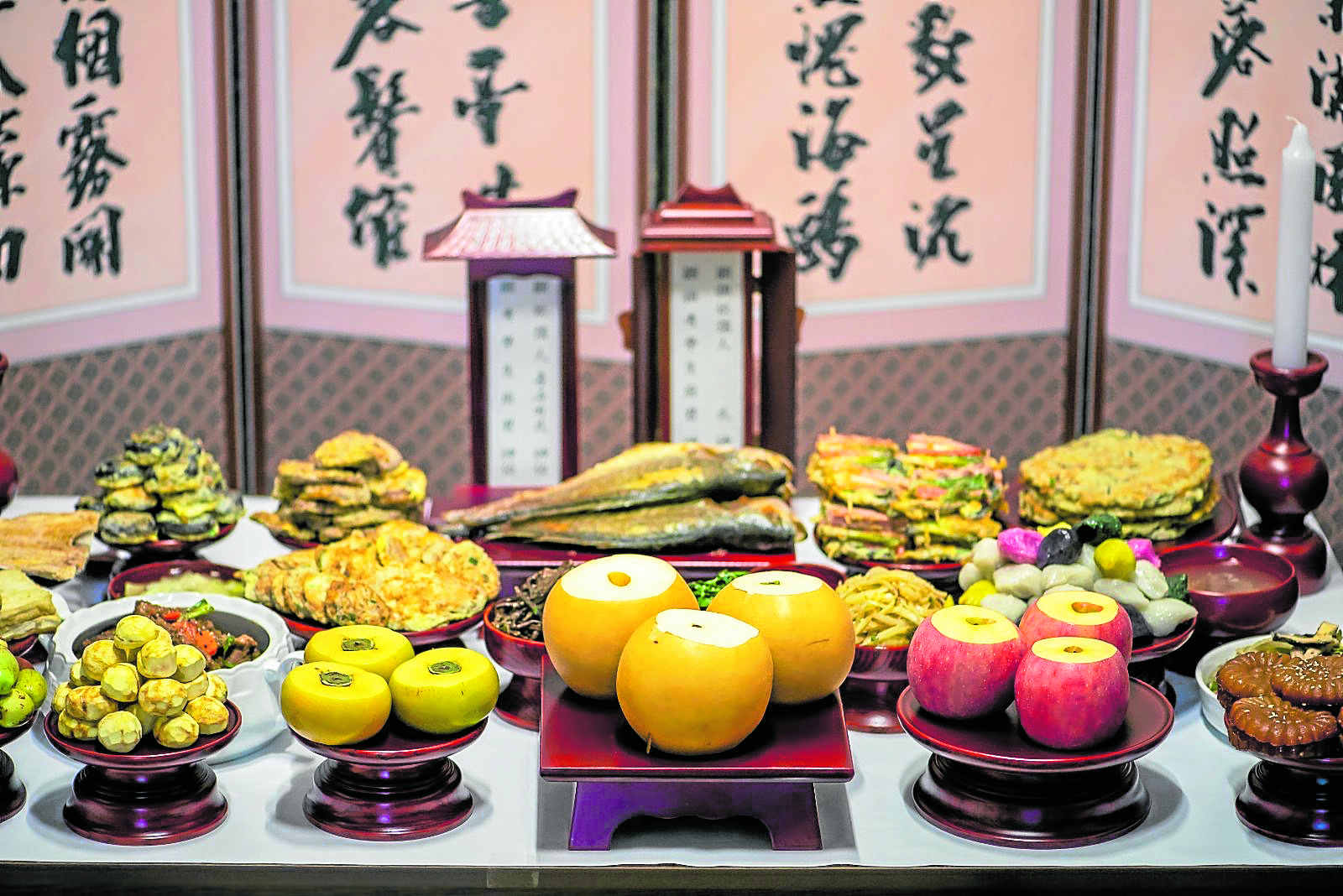
Today, Oct. 1, is Chuseok, Korea’s most wonderful and generous time of the year. It is when grains and fruits are plentiful. Chuseok is Korea’s Thanksgiving Day, that takes place on the 15th day of the eighth lunar month.
At this time, families come together, get dressed in nice clothes or in traditional hanbok, play games and feast on thanksgiving fare.
The celebration begins in the morning. Ancestral rites are performed and prayers are offered in thanksgiving for a good harvest.
Korean food expert and chef Lily Min explained that the food offered to the ancestors is symbolic and laid out in a specific manner. Each offering has a corresponding place and direction, following the principles and the harmony of eum and yang (yin and yang).
The highlight of the ancestral table is songpyeon, traditional Chuseok rice cakes (made from freshly harvested rice, steamed in pine needles), fish, meat and freshly harvested fruits and crops.
Lily shared recipes of dishes representative of this special holiday and talked about why they are served at this time.
Pungseonghan hangawi dweseyo! Happy Chuseok! Wishing you abundance today and always! Gumbae! (Cheers!)
Dak Jjim (Soy sauce braised chicken)
This is a popular celebratory dish. It is said that chickens are tastiest and fattest at this time, as they, too, feast on the abundance of nature. The use of ingredients at their prime such as chestnuts, mushrooms and jujubes adds layers of flavor and texture.
1 kg chicken
1 onion
1 potato
4 shiitake mushrooms
5 dried jujube
1 Tbsp vegetable oil
Sauce:6 Tbsp soy sauce
3 Tbsp cooking wine
2 Tbsp sugar
3 Tbsp finely chopped green onion
1 1/2 Tbsp minced garlic
1/2 tsp black pepper
1 Tbsp sesame oil
2 cups water
Chop chicken into bite-size pieces. Clean and remove excess blood.
Cut the carrot and potato into the shape and size of the chestnut. Chop the onion into big pieces. Chop the shiitake mushroom into four pieces. Peel the chestnut. Clean the dried jujube with a wet paper towel.
Coat the pot with oil and stir-fry the chicken. Add carrot, onion, shiitake mushroom and chestnuts while continuing to stir-fry.
Add 2/3 of the sauce and cook over medium heat. While it simmers, add the rest of the sauce and dried jujube.
Mix thoroughly and simmer until ready.
Jabchae (Stir-Fried Glass Noodles with Vegetables and Beef)This is typically served during birthdays, weddings, holidays and all festivals, as noodles symbolize longevity.
Jabchae means “mixture of vegetables.” The original jabchae recipe did not include meat or noodles. It was when glass noodles were introduced in Korea that the recipe turn into the jabchae we know today.
180 g glass noodles
1/3 piece carrot
1/2 piece onion
A little salt
60 g Korean chives
5 pieces dried shiitake mushrooms
100 g beef
1 egg
2 Tbsp vegetable oil
1 Tbsp sesame seeds
Sauce for mushroom and beef:1 Tbsp finely chopped green onions
1/2 Tbsp minced garlic
2 tsp soy sauce
1 tsp sugar
1 tsp sesame oil
1 tsp sesame seeds
A little black pepper
Noodle sauce:6 Tbsp soy sauce
4 Tbsp sugar
4 Tbsp sesame oil
1/4 tsp black pepper
Soak glass noodles in hot water until soft. Drain. Cut the noodles shorter.
Slice carrot and onion into thin strips and season each separately with a little salt for 10 minutes. Pat both dry with a paper towel.
Cut Korean chives into 2-inch-long pieces. Clean shiitake mushrooms and soak in hot water until tender. Remove stem and slice into thin strips, then season with half of sauce.
Wipe beef dry with paper towel and cut into thin strips. Marinate with the remaining sauce.
Beat egg slightly, then pan-fry. Slice into thin strips after.
Oil and stir-fry each of the main ingredients separately until half-cooked.
Heat a wok and stir-fry the noodles with half of the noodle sauce. Cook until sauce is absorbed by the noodles
Add in all the prepared ingredients and adjust taste accordingly with remaining half of the noodle sauce. Stir-fry for a few more minutes.
Turn heat off, add in chives and egg, then mix well. Sprinkle the top with sesame seeds.
This recipe is from the “K-Drama Cookbook” that Lily and I penned. There are so many tips and variations to this recipe, so don’t forget to get yourselves a copy.
Bae-hwachae (Pear Punch)Hwachae is a traditional Korean punch made with various fruit or edible flower petals. This recipe is made with freshly harvested pears and schisandra (also known as omija or magnolia berry), plentiful at this time of year. This punch is beautifully presented with flower-shaped pieces of Korean pear.
1 Korean pear
1 c omija concentrate (available in Korean stores)
3 c water
1 Tbsp pine nuts
Peel the pear, cut it into a flower shape, and soak it in sugar water for a while so that the color does not change.
Combine omija concentrate with water. Adjust according to taste. Leave mixture to cool and before serving. Add flower pears to float before serving.
www.reggieaspiras.com; @iamreggieaspiras on IG and FB








































